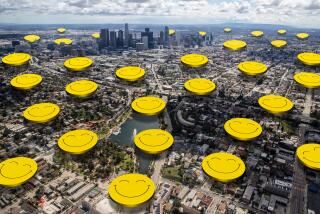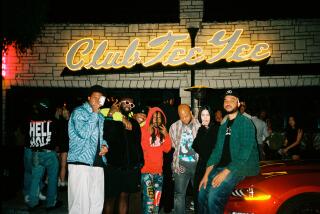Some Telling ‘Encounters’ With Los Angeles
RIVERSIDE — These days, every other artist in the basin seems to take an aesthetic shot at L.A. Since such forays into millennial soul-searching frequently go awry, it’s rewarding to see the impulse nailed perfectly in the work of Douglas McCulloh.
His exhibition “Chance Encounters: The L.A. Project” at UC Riverside’s California Museum of Photography contradicts the usual beef with installations as either too obscurely arty to make their point or too preachy to be appreciated. McCulloh’s version is intrinsically fascinating, sociologically revealing and artistically instructive.
McCulloh’s working method avoids pitfalls by adopting the Dadaist strategy of leaving things to chance. Starting his Angeltown opus in 1992, the artist gridded our map into 5,151 quarter-mile squares of urban sprawl. He selects areas at random, spending a day shooting whatever he finds--beach, slum or riverbed slime.
Knowing this, we’re convinced McCulloh is innocent of agenda. We’re also impressed that his megalopolis is incredibly tacky. Well, the guy wouldn’t be an artist if he didn’t have a point of view.
His expressive attitude is more or less automatically achieved by working in noncosmetic black and white and fitting his Nikon with an 18-millimeter lens. Such a wide-angle view guarantees weird pictures. McCulloh’s talent, however, dictates a wondrous weirdness. He’s never unsympathetic, never mawkish.
Empathy is also tied to his working habits. Most street photography is a hit-and-run proposition. By contrast, when McCulloh shoots, he chats with most everyone willing. He never takes a picture without the subject’s permission unless by accident.
As a result, the pictures feel engaged and concentrated. Each includes a brief narrative. The photographer’s prose has a nice clipped film noir tone.
The catalog frontispiece looks like a classic in the making. A cowboy type with sombrero and steed equally white lopes along the L.A. River bank near a graffiti-clogged retaining wall.
McCulloh tells us the rider’s name is D’ihigi. He grew up in Watts and became a successful professional jockey inspired by a grandfather who tended horses on a Southern plantation. Now D’ihigi rides for recreation.
That reality doesn’t erase a fantasy implicit in the picture. Viewers grounded in L.A. stereotypes will see one of the town’s myriad Lone Rangers galloping to a B-movie rescue .
The artist shows a rare knack for mixing anecdote and archetype. One image shows him at a San Fernando Valley yard sale shooting a self-portrait in a bright mirror. It looks like a seer’s crystal ball. Another man stands shadowed in the background wearing a hiked-up shirt. His head is hidden by a hand-lettered sign reading, “2 week free rent. $250 move in.” The juxtaposition bespeaks all artists lost in the bright world of their vision, oblivious to harder realities. It’s a bit of self-deprecation that doesn’t actually apply to McCulloh.
Although each of some 80 prints stands on its own expressive feet, stories enrich images. One photo captures a girl posing in front of our tatty trademark Hollywood sign. The girl’s new shorts, billed cap, sunglasses and sports shoes identify a tourist.
McCulloh’s little tale, however, hips us that this is Universal City and the background is fake. How trenchant. People travel to see the real Hollywood, but still prefer its illusion. We also learn that the artist worked next to a guy who makes a meager living clicking the same image. Wonderful nuances.
Stalking Huntington Park, our man was attracted to a crime scene. Two cops tie plastic tape lettered “Police Line.” Their shadows fall ominously on asphalt also bearing the clothing that paramedics tore away to treat the 14-year-old shooting victim.
McCulloh shows an LAX jet rising sharply above the main runway. In the foreground stretch archeological traces of a neighborhood obliterated to make way for technology. A street-corner preacher brandishes his bullhorn. Two teenage girls grimace for the camera while wondering if they should chance crossing a freeway onramp that acts as the border between gang territories.
In the Valley again, the photographer encountered a man hunkered down by one of a small caravan of clunker trucks. They’re filled with good castoffs destined for resale in Mexico.
Things aren’t always grim in McCulloh’s L.A. In the Crenshaw district’s Windsor Hills, a handsome African American couple’s wedding finery and waiting limo underscore a resident’s claim that this is “the richest black neighborhood in America.”
The exhibition’s melding of the intimate and the epic, simply put, add up to the best thing of its kind I’ve ever seen.
“Chance Encounters” was curated by California Museum of Photography director Jonathan Green. Its fully illustrated catalog includes relevant scholarly essays.
* “Chance Encounters: The L.A. Project,” UC Riverside, California Museum of Photography, 3824 Main St., Riverside; through Jan. 3, closed Mondays and Tuesdays. (909) 784-3686.
More to Read
The biggest entertainment stories
Get our big stories about Hollywood, film, television, music, arts, culture and more right in your inbox as soon as they publish.
You may occasionally receive promotional content from the Los Angeles Times.










